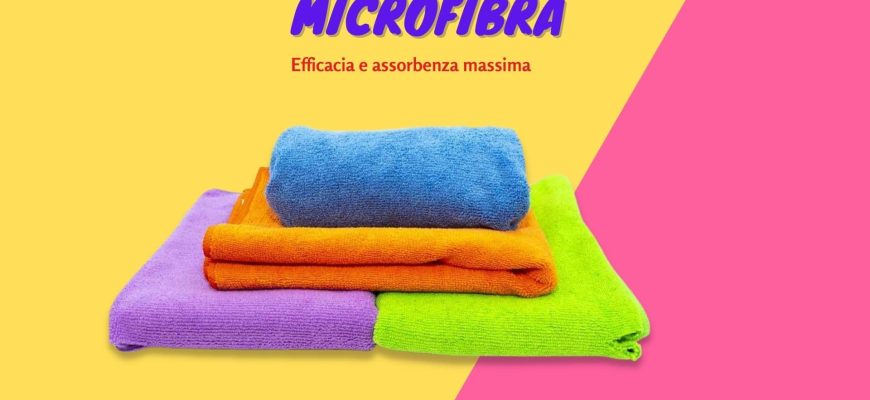- 4 January 2022
- in Household cleaning
- by Vesuvio Store
- 2772
- 0

Simple and very useful, in recent years microfibre cloths have started to be used more and more in both professional and domestic cleaning. There are many models on the market, making it difficult to choose the most appropriate type. In this article we will therefore try to put our know-how at the service of our readers, providing some key information to help in the choice of the most suitable microfibre cloth according to the different needs. Translated with www.DeepL.com/Translator (free version)
First of all, let's take a general overview of microfibre. This term does not indicate a single material, but on the contrary it refers to a combination of different technofibres, i.e. chemically treated materials that provide excellent performance in the presence of particular types of dirt.
The most commonly used fibres are polyester and polyamide, because they are able to ensure elasticity and optimum dirt-holding capacity without damaging the surfaces. An advantage of microfibre cloths is that they do not require detergents, as they can remove dirt without detergents, but with water.
The different types of microfibre are identified by a specific unit of measurement, called Dtex, which stands for textile money. For a cloth to qualify as microfibre, its Dtex thickness must be less than 0.7. Depending on the type of fabric used, the cloth will be more or less suitable for different uses.
For example, thinner microfibres will enable more thorough cleaning. It is now possible to produce ultra microfibre solutions as thin as 0.188 Dtex.
It should also be noted that polyester ensures an electrostatic action, while polyamide is associated with the absorbent function of the cloth itself. Their combination must be balanced and, above all, both must touch the surfaces to be cleaned, as the former will attract dirt and the latter will capture it permanently.
Types of microfibre cloths
Vesuvio and its engineers have designed microfibre cloths specifically for the different surfaces to be treated, in order to study the composition and thickness best suited to the individual use.
With this in mind, we can therefore classify the different microfibre cloths in this way:
Universal microfibre cloths, suitable for all surfaces, leave no marks and can be used wet or dry.
Microfibre cloth for glass: ideal for all surfaces that need a solution that leaves no haloes or lint, but at the same time is gentle and non-scratchy. This makes it ideal for windows, mirrors and any glass object.
Microfibre dust cloths: ideal for attracting and trapping dust from any surface in the home
Microfibre cloths for computers and smartphones: small and delicate, they come in a convenient boxed package for easy use
Microfibre and cotton floor cloths with double action.
The microfibre will attract the dirt, the cotton will make it easier to catch it but also easier to wring it out. This solution is also perfect for any type of floor, from porcelain to parquet.
Dual-action microfibre floor cloths with one side specially developed for removing and holding dirt, and the other for drying and polishing even delicate surfaces.
Microfibre cloths Vesuvio
Microfibre cloth: how many people can say they have never used one? How many people can say that in the laundry cupboard, where all the detergents and cleaning cloths are kept, there are at least a few examples? Probably very few, if any. After all, this object is practical and economical, versatile enough and even (moderately) green.
And let's take a look around: the shelves of supermarkets and household shops are now full of cloths, rags and dishcloths all made of microfibre. There must be a reason for this, right? The Vesuvio Microfibre Cloths lines are designed to meet all cleaning needs, even the most stubborn.
Have you ever tried them?
Rely on Vesuvio's experience, clean quality for over 30 years.


